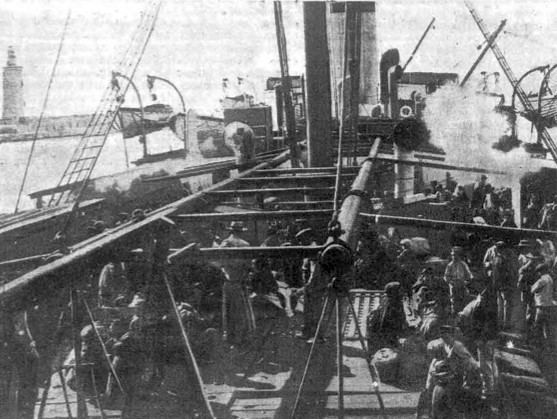 | ||
Spanish immigration to Hawaii began in 1907 when the Hawaiian government and the Hawaiian Sugar Planters' Association (HSPA) decided to supplement their ongoing importation of Portuguese workers to Hawaii with workers recruited from Spain. Importation of Spanish laborers, along with their families, continued until 1913, at which time more than 9,000 Spanish immigrants had been brought in, most recruited to work primarily on the Hawaiian sugarcane plantations.
Contents
Early immigration
Perhaps the first Spanish immigrant to take up residence in Hawaii was Francisco de Paula Marín (1774-1837), a self-promoting adventurer who knew several languages, and served King Kamehameha I as an interpreter and military advisor. Later Marin may have advised Kamehameha's son Kauikeaouli (Kamehameha III) on Hawaii's fledgling cattle industry, as Marin had spent time in Spanish California, and Kauikeaouli visited there in 1832 to observe the California cattle industry first-hand. Kauikeaouli was greatly impressed with the horsemanship and cattle handling skills of the Spanish vaqueros of California, and he invited several of them to Hawaii to teach those skills to his own people. The native Hawaiians these vaqueros trained became the "Paniolo", or "Hawaiian cowboys", who carry on a tradition of horsemanship and cattle ranching to the present day. There were no doubt other Spanish adventurers who arrived throughout the mid-19th century on whaling ships, but their numbers would have been few. Spanish immigrants to Hawaii in fact were so few prior to 1900 that they were counted only as "Other Foreigners" in the Hawaiian census returns.
Immigration of 1907 to 1913
The rise in the late 1800s of the sugar industry in the Hawaiian Islands created a huge demand for laborers to work on the sugarcane plantations. The Hawaiian government, with the support of the plantation owners, initially brought in contract laborers from China to fill this need, but public sentiment gradually turned against continued importation of the Chinese, and Portuguese workers were recruited to take their place. However, the high cost associated with shipping Portuguese laborers and their families to Hawaii, and the reality that many Portuguese remained on the plantations only long enough to fulfill their contractual obligations, led the Hawaiian Sugar Planters' Association (HSPA) to encourage the government to consider alternate sources of labor. Spain in particular was felt to be a viable source of contract workers, who were culturally more acceptable than many of the other ethnic groups that had already been brought in.
The importation of Spanish laborers to Hawaii began in 1907, when the British steamship SS Heliopolis arrived in Honolulu Harbor with 2,246 immigrants from the Málaga province of Spain. However, rumored poor accommodations and food on the voyage created political complications that delayed the next Spanish importation until 1911, when the SS Orteric arrived with a mixed contingent of 960 Spanish and 565 Portuguese immigrants, the Spanish having boarded at Gibraltar, and the Portuguese at Oporto and Lisbon. However, the two groups argued and fought with each other during the long voyage, "so much so that they had to be separated. The women . . . went as far as hair pulling." Although Portuguese immigration to Hawaii effectively ended after the arrival of the Orteric, the importation of Spanish laborers and their families continued until 1913, ultimately bringing to Hawaii a total of 9,262 Spanish immigrants.
Despite hopes that the Spanish immigrants who came to Hawaii would stay and continue to work on the sugarcane plantations, most emigrated to the mainland United States, generally California, as soon as they could in search of greater opportunity. So much so that the U.S. census for 1930 listed only 1,219 residents (0.3% of the population) of Spanish ancestry still remaining in Hawaii. Although the Spanish tended to move on, they were quickly supplanted by Spanish-speaking immigrants from the Philippines and Puerto Rico, who by 1930 made up, respectively, 17.1% and 1.8% of the population. By comparison, residents of Portuguese ancestry in 1930 made up 7.5% of the population.
How they came to Hawaii
Six ships between 1907 and 1913 brought over 9,000 Spanish immigrants from the Spanish mainland to Hawaii. Although many of the Portuguese immigrants who preceded them to Hawaii arrived on small wooden sailing ships of less than a thousand gross tonnage capacity, all of the ships involved in the Spanish immigration were large, steel-hulled, passenger steamships.
